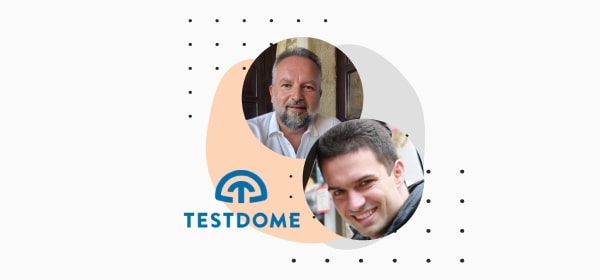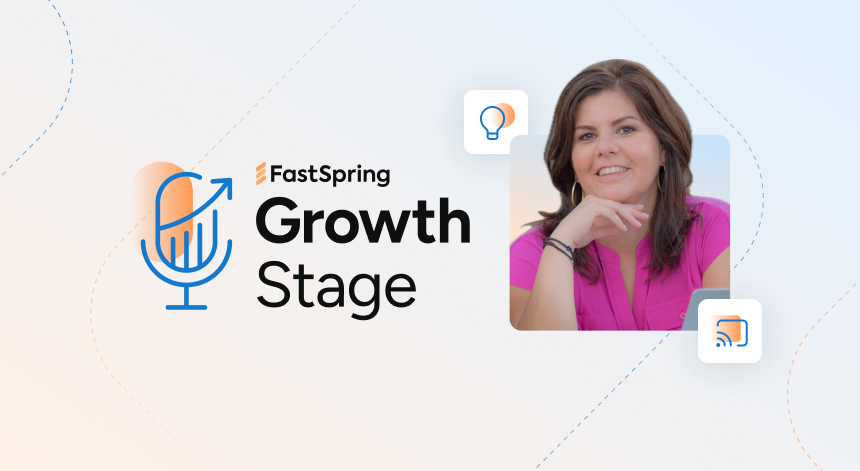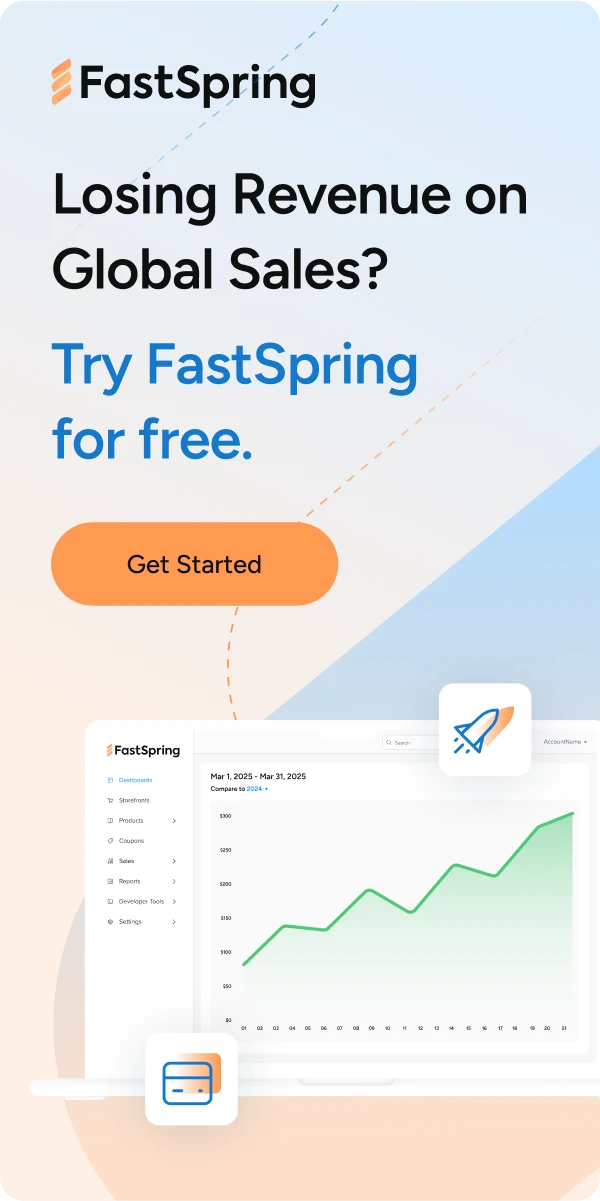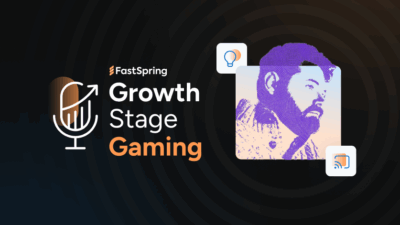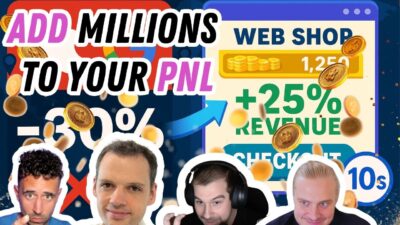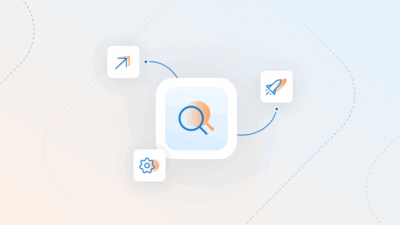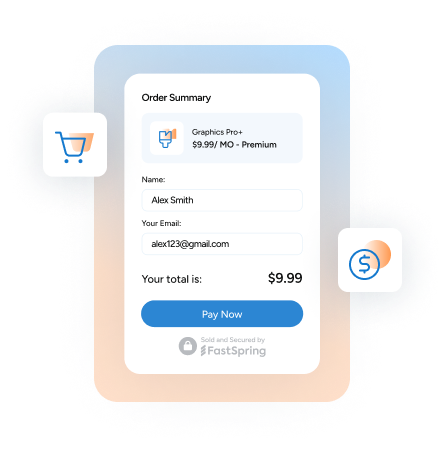Your personal brand is more than a polished LinkedIn profile — it’s how you stand out, connect with customers, and build long-term credibility as a founder or executive. But how do you create an authentic personal brand that actually works?
In this episode of Growth Stage, we talk with Rachel Gogos — Founder and CEO of brandiD — about her SOULiD framework and how digital business leaders can craft a brand that reflects who they truly are, while supporting their business goals.
Rachel shares:
- What makes up a strong personal brand (and why every founder already has one).
- How personal branding boosts clarity, confidence, and even company resilience.
- Practical ways SaaS leaders can uncover and express their unique identity.
- Mistakes to avoid (like overusing AI or oversharing on social media).
- Why consistency matters more than perfection.
If you’re a founder, executive, or thought leader looking to stand out and connect with the right audience — without turning into a personal branding cliché — this episode is for you.
Jump to video. | Jump to transcript.
Podcast Full Interview: Audio
Listen online or find it on more podcast services.
Podcast Full Interview: Video
Transcript
Jesse Paliotto (00:04)
Hello everyone and welcome to Grow Stage podcast by Fast Spring where we discuss how digital product companies can grow revenue, build good products, increase their value. I’m your host, Jesse Paliotto I get to be part of the digital product community as part of my role with Fast Spring and I love bringing the best of the community to you here. So I’m excited today to have with us Rachel Gogos, CEO at Brand ID. Rachel is a true web pioneer, founder of Brand ID. She started her impressive career.
actually at the United Nations headquarters in New York, helping create their first website. Later held positions at Wall Street, dowjones.com. With over 15 years of marketing and communications experience, Rachel now channels her passion for people and the web into building strong personal brands for her clients. Her entrepreneurial journey includes multiple companies, which is amazing, including Brand ID, My Path 101, co-founding an internet incubator in the 90s. So honored, Rachel, to have you here today. Thanks for doing this. I really appreciate it.
Rachel Gogos (00:59)
it’s great to be here.
Jesse Paliotto (01:01)
Just to give folks context, can you briefly describe what brand ID is? We were just talking about this before we started the episode, even maybe what the name means and what the company does that you lead right now.
Rachel Gogos (01:07)
Mm-hmm.
Yeah, absolutely. So brandiD is a web agency and we are, I like to say brand led, meaning that the majority of our work always starts out with brand and business strategy. And then it goes into web, all the things needed for websites from copywriting, design, development, to pushing out WordPress websites is the majority of the work that we do.
We build sales pages, courses, membership sites, e-commerce sites, podcasts, podcasts for other clients as well. So yeah, that is the primary part of our work. In terms of the name, brandiD was launched in 2007, late 2007, and it was really so hard to come up with a name for your company.
But somehow I came up with brandiD. I think it could have been divine intervention. That’s usually where my names come from. I pray about it a lot. And finally, God dropped something hopefully good in there. So brandiD, the ID stands for identity, because we’re building business identities and personal brand identities. And also for id, which in Freud’s analysis of personality, the id is the part of the personality that we’re actually born with.
And for our work, we want to tap into the most authentic side of a person. In fact, our framework is called the Sole ID Framework because that is the way to differentiate yourself on the web and really grow and scale your business, I believe.
Jesse Paliotto (02:53)
That is awesome. I love kind of like the it’s very kind of Deep it can come off as just brand did but no there’s a lot of meaning and layers and and true applicability to like what the company does How did you get into this is there a particular point where you realize like This is what’s needed in the world or you know this is just something I’m natural like what was the impetus? How did you get into this?
Rachel Gogos (03:02)
Yeah.
Yeah.
So funny story, when I lived in Manhattan, it was in the 90s, and I was working at Dow Jones, but also started a business with two business partners called Silicon Fish. And with Silicon Fish, we were an internet incubator, but to make money to keep living, right? And covering our expenses besides our day job, one of my business partners is an incredible designer.
And we literally were going door to door to brick and mortar companies, again, the 90s, and being like, hey, do you need a website? Because the internet was just starting to become a thing. And so fast forward, that was late 90s, like I said, and I launched brandiD in 2007. So I moved to Boston, worked in internet consulting for a while, also worked with the mayor on bridging the digital divide, so still technology.
between low income and technology, bridging the digital divide for low income families and in the Boston public schools. Then I moved to Pittsburgh and I was working at an organization as a vice president of marketing and I read an article in Time Magazine that was about this new thing called personal branding. And the article was all about a particular founder of a company called Reach Personal Branding.
And it described how personal branding was like bringing the stories and the marketing of people to, you know, bring the human element, which I found fascinating because I had this passion for people and their stories and what made them tick and how they figured out what to do with their lives. So I, I joined the, a certification program and personal branding from this person I read about in time magazine. So I worked directly with him for three months. And then that business partner from New York city,
We were still in touch. I said, hey, I’m thinking of starting a business. Why don’t we do it together? And he’s like, no, we’re not going to do it together. You can do it on your own, but I’m going to work with you. So I always wanted to have web design as part of brandiD, because as I was sharing before, think coming up with a strategy is great and necessary. But if you can’t implement that strategy and so many people get stuck in that, you have nothing.
and you’ve paid a lot of money for something with no results. If you just go into implementation mode without being strategic, chances are that’s going to fail too. So I always wanted brandiD to do both, which is why we always start out with strategy and why the implementation part is about building the web presence. And we get really tactical besides websites. We also do a lot of content marketing retainers for clients or build out, like I said, podcasts for them.
Everything we do is about building the visibility of the founder or the thought leader behind the personal brand.
Jesse Paliotto (06:11)
Yeah, and I want to ask a little bit more about implementation and like how do you actually do it. But let me, I want to ask a little bit more kind of maybe conceptually. What makes up a personal brand, especially for someone who’s a CEO or a business leader or an entrepreneur? Like I feel like that different people may interpret that phrase differently. And like for you, what is it, what are the components of that? What makes up a personal brand?
Rachel Gogos (06:15)
Yes.
Yeah.
Yeah.
Mm-hmm.
Mm-hmm.
Well, I like to say it’s a cocktail and it’s a three-part cocktail. It’s part personality, right, which we all have. It’s part marketing because we have to get that personal brand out there. And it’s part like our true reputation. That’s the third part, which again, we all have. And part of the personality piece again is like, what is your true essence? Like what is your true DNA?
Tapping, so if you tap into that piece, that personality and the reputation piece, but then market that. And by marketing, I don’t mean you have to like brag about it or be really loud about it, but just finding ways that are aligned with your personality to express what you do in the world. So everybody has a personal brand, right? We all have a reputation and we all have a personality. So that third part of the cocktail is the part that we
we really tap into after we’ve helped a person get clear on uncovering their personal brand? Because it’s a very common question what you ask. People don’t think they have a personal brand, but again, we all do.
Jesse Paliotto (07:47)
How does somebody uncover their personal brand or how do you help people do that?
Rachel Gogos (07:53)
Yeah, we have a process it’s called the like I mentioned the sole sole ID framework. The S in sole stands for strategize. And so that first part of our process is where we really dig deep with a person, whether it’s a business brand or a personal brand. We ask that I’d like to say their basic questions that once we hit adulthood and probably even in our teenage years, we never
never take the time to ask ourselves are just introspective questions like, you know, what’s your mission in life and what’s your vision and what kind of legacy do you want to leave behind and what makes you different? You know, even of other people doing the same thing you are, how are you different and what are your passions and what are your strengths? Again, like these are not difficult questions, but you know, once we get on the hamster wheel of life, like we’re not really sitting around pondering who we really are at our core.
But if we take the time to do that, first of all, the answers to those questions don’t shift a whole lot. Like our values are really our values. Maybe our vision changes or our mission as we gain experience, right? And we live different experiences. Some things can shift for us. They can make a great impact on us and cause those things to shift. And of course we all evolve as humans and that’s really important. We all hopefully progress and develop.
Jesse Paliotto (09:12)
Yeah.
Rachel Gogos (09:17)
But again, just getting clear on those fundamental, basic foundational questions really, I like to say it really helps set the GPS of what you’re building. It really helps you get clear on the direction that you want to go in. And getting clear on those answers can help you identify like what type of company am I building? Is it a lifestyle brand or do I really want an exit? know, do I want to take on investors?
do I want to just grow it on my own? You do I want to have employees or do I want to just have 1099s or is this a solo business? Right? Because again, when we understand who we are and what makes us tick, then we can answer those types of questions.
Jesse Paliotto (09:44)
Interesting.
Yeah, that’s interesting. And just to kind of make sure I got what you said, there’s sort of there’s your personality. There is the actual marketing of it. And then there is your reputation. And so kind of using questions to refine maybe number one and number three there, but then using some of the tools to share that through some good marketing. And you actually started I wanted to ask and you may have started to answer there like what why is developing it important? I realize that’s probably the dumb question in the room. Like you’re like, you know, this is
Rachel Gogos (10:06)
Yeah. Yes, exactly.
Correct.
No, not at all.
It’s a great question.
Jesse Paliotto (10:27)
This is assumed maybe
at some level, but what does the impact really look like? It sounds like part of that impact could be helping a business leader or anybody really define goals, which is hugely valuable. Is there anything to add to that or is that kind of the probably the big home run that you get when you work on your personal brand?
Rachel Gogos (10:38)
Yeah. Yes.
Defining goals is definitely very important in a big output of it, but it’s also getting clear on your differentiators as well, right? And the other thing is like, it’s actually a big confidence boost, believe it or not, because when we know what we stand for, we can talk about those things in a way, you know, with conviction. And those also can be very sticky points, both in a positive and negative way.
Jesse Paliotto (10:54)
Hmm. Yeah.
Rachel Gogos (11:16)
to attract our ideal clients, right? So that values piece, or again, like just getting clear on, know, think of some brands you might support. The founder may also be articulate about some causes that are really important to them. And in today’s world, the consumers are so much more savvy around companies they’re supporting or not supporting, right? And they’re really using their dollars to kind of like,
Jesse Paliotto (11:19)
Interesting.
Yeah.
Rachel Gogos (11:45)
vote or support the growth of a company, right, or not. And so getting that clarity about ourselves, again, brings that confidence. It can also be polarizing in a positive way to attract our ideal people towards us. But it also, I think, builds resilience for those times in life and in every owner faces this when you’re like, man, it’s been really hard for a couple of months.
whatever it is, like is it cash flow? Is it employee turnover? Is it, you know, your just not your inability to scale or a project gone south or a client that’s unhappy, whatever it is. But sometimes we go through these periods where you stop and you say like, why am I really doing this? And again, if you’re clear on those questions, those basic questions, it can really help you just, you know, refresh and stay on track.
Jesse Paliotto (12:13)
Yeah. Yeah.
Mm-hmm.
Rachel Gogos (12:42)
Right, we need resilience as entrepreneurs. think it’s one of the top three qualities we need to be successful.
Jesse Paliotto (12:42)
Yeah.
Absolutely.
Yeah, 100%. You will run into obstacles. It’s not a question of if, it is when. It occurs to that also there’s probably a benefit, and if I’m off base, please tell me, but I’m guessing there’s a benefit in that it allows you to maybe, even in promoting your business, to cut through a little bit. Because I think one of the things that my observation is that as a consumer, as I’ve witnessed other consumers, we’re much more tuned into people. so connecting with a person who’s promoting something is much more valuable than
Rachel Gogos (12:53)
Mm-hmm. Yep.
Yeah.
Mm-hmm.
Mm-hmm.
Jesse Paliotto (13:20)
or just it’s available now with social media and the different things. And so I’m guessing that would be valuable too. Like it’s a way for me to kind of bring my company out into the marketplace better.
Rachel Gogos (13:25)
Yes.
Yeah, absolutely it is. you’re spot on, Jesse. People, no matter how large the company or, you know, I know there’s a lot of software companies that you all work with, people still want to know who’s behind the brand, right? That’s part of their buying decision.
Jesse Paliotto (13:40)
Mm-hmm.
Yeah, it’s, I talk about this with people fairly frequently about like influencer culture and how it’s interesting that so much has flipped from I’m buying this thing to I’m buying this person’s recommendation. That’s really kind of, even interestingly your story, not to connect too many dots here, but with the Times, I think it was the Times Magazine article you said, which is how you started Brand ID, right? There was that personal connection. You’re like, I want to do something like what this person’s talking about.
Rachel Gogos (13:54)
Mm-hmm.
Mm-hmm.
Yeah.
Mm-hmm. Mm-hmm. Yeah.
Yeah,
it brought it to life for me in a whole new way than just reading about what the company did. Having read about that, the person behind the company and what they stood for and just what their story was to starting that company also just brought it to life in a whole new way. And for your founders listening, the more that they can put their, even parts of their personal story,
Jesse Paliotto (14:26)
Yeah.
Rachel Gogos (14:44)
that are relevant to what they’re doing or if it talks about their struggle to what they’re doing. Ultimately, I think people are good and they want to support good people doing good things. But it’s up to us to communicate that.
Jesse Paliotto (14:44)
Mm-hmm.
Yeah, I agree.
Yeah, people don’t know what they don’t know. Sort of a, I’m just gonna swing kind of hard to a very practical question or a check-in point here. What is, is there a way that somebody could get a sense of where their personal brand is right now? If somebody’s listening to this or they’re like, oh, I haven’t, you know, I know about this, I haven’t thought about it a lot. How am I doing? Like, what would they, how would they go suss that out?
Rachel Gogos (15:01)
Mm-hmm.
Mm-hmm. Yeah.
Yeah.
Yeah, so the gentleman in the Time Magazine article actually started something called, I think it was called the Online ID Calculator. I think that’s gone away, but we don’t need the calculator to figure it out. You go to Google and you type in your first name and last name and see what your results are on your first three pages in particular.
Jesse Paliotto (15:41)
Mm-hmm.
Rachel Gogos (15:46)
and identify how relevant those results are to what you’re doing right now or how you want to be perceived right now. If they’re not very relevant to the way you want to be positioned out in the world today, then you got some work to do. If the results on those top three pages are like totally on brand for what you’re doing, for what your beliefs are, positioning you authentically but in a positive light,
then you’re in a great place. But there is work where you can do in between those two extremes, right? I know, right? Totally.
Jesse Paliotto (16:21)
Yeah. I love that. Such a simple test, the Google test.
I mean the great thing about it too is you know that’s what anybody else is going to see. any if you know if you’re trying to sell to a client or anything like that and they wonder who is this person they’re going to do exactly that. So.
Rachel Gogos (16:33)
Yes.
Yeah,
yeah, exactly. And one other thing I like to tell people, because so many people don’t do this, but buy your vanity URL. So buy your first name, last name, and the .com. And even if you have a company, it’s not so you don’t feel like it’s about building your personal brand, you should still point that vanity URL to your about page on your corporate site.
Jesse Paliotto (17:03)
okay, nerdy, very nerdy web person question. With a name like Jesse Paliotto, my vanity URL is probably very easy to come by. If my name was whatever, something very common, it would be less hard. What would you tell somebody who’s like, somebody already has Bob Stewart, what do they do?
Rachel Gogos (17:15)
Yeah, John Smith.
Yeah,
so I actually just had a call today with a woman named, her name was Melinda Johnson, which is actually a pretty common name, right? Yeah. So her vanity URL is not available, but she is a specialist in a particular type of social work or psychotherapy. So I said to her, just buy your vanity.
Jesse Paliotto (17:30)
Okay, pretty common.
Rachel Gogos (17:45)
your vanity and add the abbreviation of that particular psychological behavior or psychological type of therapy that you do on the end of your name because that’s what you want to be associated with. So yeah, so there’s typically a way to find a variation or use your middle initial even if you don’t use it a lot but that could just be like enough variation where the domain is available, right?
Jesse Paliotto (17:49)
Man.
Yeah.
Mm-hmm.
Rachel Gogos (18:12)
But I say stay away from hyphens I think those get lost and really you want to invest in the dot-com and I think it’s nice if You really built your personal brand even buying some of the extensions just so somebody doesn’t buy those out from under you like the dot org or the dotnet
Jesse Paliotto (18:19)
Mm-hmm.
Mm hmm.
Yeah, probably even more valuable with common names where people will be looking as well. So I’m. Coming away from that tactical thing, thank you that I love those kind of small small insights into like practical things you can do like right now. I’m curious, so let’s say someone says OK, I want to tackle this. What do you think are the most important things to focus on?
Rachel Gogos (18:33)
Mm-hmm. Yeah, so true.
Yeah.
Mm-hmm.
Mm-hmm.
Jesse Paliotto (18:55)
to do this and I’m kind of curious around this idea of there’s easy wins and then there’s important wins. Like there’s some things like buying that domain might probably be an easy win. Like just go out and get it. It doesn’t take long. But there’s other stuff that’s like it’s it may not be easy but it’s super important. I know if you have any thoughts around that.
Rachel Gogos (19:01)
Hmm.
Right.
Mm-hmm.
Good question, Jessie. That one’s getting me really thinking.
Jesse Paliotto (19:18)
Or it may be even like a way to come at it is from like if if I were a client with brand ID today What might be the first things that like we need to solve this or we? Typically start at this end of kind of our to-do list in order to get you on on track
Rachel Gogos (19:23)
Mm-hmm.
Yeah.
Yeah, yeah, so thank you. I would say like doing those exercises in that strategize phase, they’re actually not, they’re easy, simple questions, but they’re not easy to answer. So, but they’re important, they’re very important for sure. So taking the time to do that, really taking the time to think about where you want to be five years from now, and it doesn’t have to be super granular, but just high level enough.
Jesse Paliotto (19:40)
Hmm.
Right. Yeah.
Rachel Gogos (20:00)
And I do believe that even just having that clarity in your mind, even if you don’t put it out there, helps you get there. It’s not something that you need to share. Being clear on target audience, very important, because you want to really dive deep into the psychology of your consumer and really understand what makes them tick, what their pain points are, and how your solution can help them, what those results are and how they can help them.
Jesse Paliotto (20:08)
Yeah.
Hmm.
Yeah.
Rachel Gogos (20:29)
So again, very important. I would say knowing the type of way that you like to work and the type of content you like to create because that marketing piece is very important whether you outsource it or if you do it yourself, but just pick a path that you really enjoy. Like if podcasting is your thing, pick it and stick with it.
Jesse Paliotto (20:41)
Mm-hmm.
interesting.
Yeah.
Rachel Gogos (20:58)
doing Instagram stories or reels or any of that is something you love doing, perfect. Just pick it and stick with it because you have to be consistent. And that’s also very important and not easy actually, the consistency piece.
Jesse Paliotto (21:14)
Yeah, consistency. think, you know, all of our energy levels and distraction levels goes up and down. And so like staying on, on target, I resonate with that. That is always a challenge is you do have to just stick to discipline. is I’m curious, like if there’s any, you know, a podcast, Instagram, LinkedIn would be an obvious go-to for a very, you know, for people that are in business, definitely in SaaS or software or something like that. Is there any other interesting things people have chosen to go do as they’re like,
Rachel Gogos (21:18)
Yeah.
Mm-hmm. Mm-hmm.
Jesse Paliotto (21:44)
marketing a channel or expression.
Rachel Gogos (21:48)
Yeah, like in the software world specifically.
Jesse Paliotto (21:51)
Yeah, or any.
just I’m kind of curious even just for the like from sort of the wide angle lens of what kind of stuff do people do in order to kind of once they say, OK, I know where my personality is at. I went to Google. I know my reputation is I want to start expressing who I am. Yeah, what kind of stuff do people go for?
Rachel Gogos (21:59)
Yeah.
Yeah.
Yeah,
yeah. So be clear on your target audience and where they are. So you don’t have to be visible on every platform. You do need to be visible on the platforms where your ideal customer will be looking for you or looking for your thought leadership and opinions. And the second thing I would say is don’t underestimate the value of in-person connection, especially these last couple of years. think there’s, it’s…
Jesse Paliotto (22:15)
Yeah.
Mm-hmm.
Rachel Gogos (22:35)
you know, back on track to like pre 2020 and people I feel really appreciate the in-person way more than we did say in like 2019 because having lost it for a little while, we really understood the value of it in a whole different way and just connecting to someone deeper. And the third thing I would say, which isn’t like a direct answer to your question, but I think it’s important to share in this part, which is networking.
Jesse Paliotto (22:47)
Yeah.
Rachel Gogos (23:05)
But networking in a way that feels really comfortable and again like really honest. So I’m a big fan of like fewer deeper conversations than like the broad hit that feels like very superficial and like you know probably what speed dating would feel like because it just takes like one amazing connection to really grow, expand, whatever, grow into a partnership, whatever it might be.
Jesse Paliotto (23:05)
Mm-hmm.
Yeah.
Rachel Gogos (23:33)
And people feel that sincerity, that true connection right off the bat. So I would say those three things are really key. Get out from behind your desk, right? mean.
Jesse Paliotto (23:35)
Yeah.
Yeah, yeah, I love everything you just said. Particularly that, you you said even that last part maybe doesn’t directly, but I think it does answer the question in the sense that I can imagine somebody saying, okay, I want to do my personal brand. And for better or for worse, a lot of times our go-to assumption is I’m going to go on social media. I’m going to have to go blast out LinkedIn posts three times a day.
Rachel Gogos (23:51)
Thank you.
Jesse Paliotto (24:11)
seven days a week and put it on autopilot and make it AI generated. And we kind of go to these mass multiplier methods, but I really love that last point that so much good stuff happens just having one great conversation with the right person. And I totally agree. Like we see this in our business. It resonates in different conversations. I’ve had that, you know, we’re COVID, it was very hard to figure out when COVID tailed off for different.
Rachel Gogos (24:18)
Mm-hmm.
Mm, yeah.
Mm-hmm.
Jesse Paliotto (24:39)
parts of the world and how different communities
Rachel Gogos (24:39)
Mm-hmm.
Jesse Paliotto (24:40)
really gauge that. But we are at a place right now where people are fully like doing the in-person thing. And that feels so good after not having been able to. yeah, that’s taking advantage of that and like using that I think is very, very relevant.
Rachel Gogos (24:47)
Yes.
Yeah, yeah it does.
Mm-hmm.
Yeah, totally.
Jesse Paliotto (25:00)
So on the flip side, what would be typical mistakes? if somebody, maybe I was giving one, which is to rush off and make a bunch of AI LinkedIn content. If somebody, has you seen clients go into this and maybe stumble a little bit? Is there anything that somebody should watch out for if they’re trying to build their personal brand?
Rachel Gogos (25:02)
Mm-hmm.
Mm-hmm. Mm-hmm.
Yeah, totally. A couple things. So one, watch oversharing on the personal side. You know, sometimes people, you want to always be professional. Like, yes, be authentic and share personal stories, but don’t overshare to the point where someone’s gonna doubt your stability, let’s say, or your ability, right? That’s one thing.
Um, second thing is the overuse of AI or even the use of know, AI is a big thing, obviously, and I have not been a huge fan on personal brands. And the reason is AI lacks soul and we can train it to talk like us and sound like us, but you can read AI text.
Jesse Paliotto (25:58)
Mm.
Rachel Gogos (26:07)
and know that it’s AI because you don’t feel the emotion. And I don’t know, maybe I’m just like a sensitive person when it comes to that and I have an extensive copywriting background, but I do think there’s something felt in the written word and it’s a great shortcut. Use it for brainstorming, use it for a better title or headline, but don’t use it to write your personal brand.
Jesse Paliotto (26:24)
Yeah.
Rachel Gogos (26:35)
copy. You can use it for products, you can use it to market software, but if you’re trying to convey a thought or a feeling from you, the personal brand, don’t use it.
Jesse Paliotto (26:38)
Yeah.
Hmm. I guess all I can think of right now. There’s somebody I work with. Katie shout out to you who I think it was you. Can you said like you can tell when somebody uses the word crucial likes for some reason AI loves to use the word crucial and most people don’t naturally use that in their conversation. Yeah, so there’s just.
Rachel Gogos (27:03)
Yeah, you know what else about
AI? It’s like technically perfect writing, which makes it read robotic. And I think that’s a big giveaway too.
Jesse Paliotto (27:09)
Mm-hmm.
Yeah.
Yeah, it’s not to go too far down the AI rabbit trail, because I know it can be quite a rabbit trail. I think most people right now concede that AI is detectable in most formats. And most people’s fear is that one day it won’t be. And I don’t know, nobody knows what will happen, but I’d say for now I’m 100 % with you. You can feel the lack of.
Rachel Gogos (27:31)
Mm-hmm.
Mm-hmm.
Jesse Paliotto (27:43)
reality to it. And I would think like a big value with personal brand is giving your perspective. It is you. It feels like you. When I go talk to you in person, it sounds like you. Right. So that sort of maybe congruity or integrity of your presence is is a big thing.
Rachel Gogos (27:44)
Mm-hmm.
Correct.
Right.
Mm-hmm. Yeah, totally. Yeah, getting back to the id, right? You can’t put your
id into the AI.
Jesse Paliotto (28:07)
Not yet. Isaac Asimov said we might do it someday, but not yet. I’m curious, like, as people grow, you know, people get into this, they start, they have clarity on themselves, they’re putting themselves out there, they’re doing this. Is there anything that’s more for the long haul worth thinking about? Like if you’re already doing this, some things that might be worth thinking about as you’re kind of growing in your personal brand?
Rachel Gogos (28:10)
I hope not. I hope that’s not in our lifetime,
you
Mm-hmm.
Jesse Paliotto (28:36)
This is a very open-ended question. I’m not even sure what I would think on this matter, but I just imagine there’s people that are ahead of me in putting themselves out in the marketplace who maybe have some different concerns than I would, where I’m just trying to think about getting jessipaleotto.com registered.
Rachel Gogos (28:39)
Yeah.
Mm-hmm.
Mm-hmm. So you’re wondering what can people do like after some of the basics are done or okay? So it
Jesse Paliotto (28:58)
Yeah.
Or even maybe pitfalls that they run into later on once they kind of get into this and they’ve been doing it for a year or two. But yeah, like what do they do after the basics? And then are there any common obstacles they run into long term?
Rachel Gogos (29:06)
Yeah. Yeah.
So some of the obstacles are again, longevity and that consistency piece. does get tiring, especially if you’re not really seeing immediate results. And we’re living in a time where immediate results are what most people are looking for. So just stick with things. It takes people time now and more time to make a purchasing decision.
Jesse Paliotto (29:22)
Mm.
Yeah.
Rachel Gogos (29:36)
And of course, higher the price point on that purchasing decision, the longer it takes them to make. But if people can find some of your thought leadership, even if it’s old stuff, you never know what somebody is going to find about you on a Google search. And so just know that the more content you have out there, again, that’s relevant to what you’re doing or trying to sell, the better it is. That’s one thing.
Jesse Paliotto (29:41)
Hmm.
Yeah.
Rachel Gogos (30:01)
Another thing is creating thought leadership. So if you are in an industry and you want to be perceived as a leader over time in that industry, start writing for other, like, influencer blogs or publications.
besides just your own companies. And also, particularly on LinkedIn, those long form posts on LinkedIn, I think are a great way to exhibit strong thought leadership. And again, connecting with influencers on there, commenting on influencers content in a way that shows that you have your own opinion about something too is over time. really helps. It’s like accumulative interest. It works the same way as money does, right?
Jesse Paliotto (30:22)
Mm-hmm.
Yeah.
Rachel Gogos (30:50)
And also, again, like being at events that are important, key to your industry, that’s another way to really improve your thought leadership. Authoring a book, even if it’s just a digital book, but a book is like a huge way to show your thought leadership and get your opinions out there and start creating some influential work under your personal brand.
Jesse Paliotto (30:59)
Mm-hmm.
Yeah.
Mm-hmm.
Rachel Gogos (31:19)
Those are the primary things that come to mind. Because in that we got speaking, we have the authoring, content, whether online or like a physical book. again, that consistency in producing content.
Jesse Paliotto (31:25)
Yeah.
Yeah, that’s great. And something you said kind of early in that paragraph, I don’t know why, it just fired a neuron for me of the equation should be if you’re a SaaS or CEO or executive or salesperson or anything in a company, that your commitment to producing consistent content should be at least equal to your product sales cycle. So if your product takes six months to sell,
Rachel Gogos (31:43)
Mm-hmm.
Hmm.
Mm-hmm.
Jesse Paliotto (32:05)
You should be
out there. You should commit to doing six months worth of consistent communication if you’re trying to get in front of people and get to that point. And that’s best case scenario that somebody saw you talking on day one and immediately started considering your product and getting to a place of purchase in six months. Reality is, your brand presence is gonna grow. So actually it should be probably some multiple of that. But I don’t know why, I’ve just never thought of it in equation terms before.
Rachel Gogos (32:12)
Mm-hmm. Yeah.
Yeah.
Yeah, yeah.
Yeah, no, that’s really interesting. That is really interesting. I remembered the other thing I wanted to share, which is people’s attention spans nowadays is so minimal. You know, we have something like three to five seconds to really grab somebody’s attention on the web with content that we’re producing. So that’s the other thing to be mindful of is if you’re a true thought leader, over time, people will start seeking out your content. It’s not that you’re gonna have to be
Jesse Paliotto (32:35)
Maybe.
Hmm.
Rachel Gogos (33:02)
Of course you’re fighting for attention always, but if you kind of prove yourself within your industry and what you’re doing and you’re saying the thing that maybe not everybody is saying, because you truly believe it, not just because you’re trying to be provocative, but because you really believe the thing that you’re saying, people will start seeking your content out. And that’s when you know that you’ve really kind of hit a sweet spot, when you can cut through the noise that’s out there and really capture people’s attention.
Jesse Paliotto (33:05)
Yeah.
Yeah.
Yeah. And I mean, I’m sure all of us, I know I can certainly think of people that I follow that I do that. I’m like, I want to know what this person says about this topic or I don’t care what they’re talking about. I want to listen to them because I love the stuff that they say. Yeah. So that’s a very real thing. There’s a quote too, which I’m going to totally butcher, but it makes me think of, believe…
Rachel Gogos (33:39)
Mm-hmm. Mm-hmm. Mm-hmm.
Mm-hmm. Mm-hmm.
Yeah.
Jesse Paliotto (33:56)
I’ll try and grab the true quote and throw it in the show notes. But basically it’s what’s most personal is what is most universal. So there’s this idea that, which I think is just trying to capture what you’re saying. Like if you’ll truly say what you really think it’d be you, not some provocative kind of stuff, that actually goes the most distance in connecting with people truly.
Rachel Gogos (34:05)
Mmm.
Yeah, right.
Mm-hmm, mm-hmm. Because again, it’s felt, right? You can feel authenticity.
Jesse Paliotto (34:24)
Yeah, 100%. This has been so good. I wanted to ask just where people can connect with you. So if there’s folks out here that like, I love this, and maybe brandiD could help me. What are the best ways for people to get in touch with you or with the company or to follow up?
Rachel Gogos (34:34)
Mm-hmm.
Yeah.
Yeah, so you can visit our company site, which is the brandid.com, so T-H-E-B-R-A-N-D-I-D.com, or reach out to me personally on LinkedIn. I’m just under my vanity name, Rachel Gogos over there.
Jesse Paliotto (34:59)
Awesome. Anything that we didn’t get to touch on or like last thoughts or anything where you’re like, Jesse, I was going to say this and you didn’t give me a chance to say it. And if not, no worries.
Rachel Gogos (35:07)
Yeah, one thing that comes to mind is repetition. Just because you’ve said something once, twice, three times, don’t be afraid to say it over and over and over again, even if you’re using slightly different language, because it takes people six, seven, eight times sometimes to read something and it really sinks in. And I know, because I personally don’t love social media. I’m a bit of a social media introvert, but obviously it’s important for the industry that I work in.
Jesse Paliotto (35:12)
Hmm.
Rachel Gogos (35:37)
And you can put some posts out there about certain topics or ideas or opinions, and maybe you don’t get a whole lot of traction on it, or it lands flat for whatever reason. But say the same thing over and over and over again, because over time, that content will be associated with you, especially if it’s a philosophy or an idea within your industry. But also, again, because people just, you gotta cut through the noise and
Jesse Paliotto (35:37)
Yeah.
Rachel Gogos (36:07)
You want people to read something several times before it really sticks with them. You need them to.
Jesse Paliotto (36:12)
Yeah, we have such a I don’t know what the right term is for it, but like a disconnect between how we assume other people look at our stuff versus how we actually look at other people’s right. So I’m like anybody even the people I really like that I’ll follow. I don’t see 90 % of what they do, but for some reason I think everybody is going to see when I drop that one thing up on LinkedIn. You’re like why no one else you didn’t see anybody else’s.
Rachel Gogos (36:20)
Yes. Yes, so true.
Yeah.
Yes. I
know. That’s such a great example.
Jesse Paliotto (36:40)
And so it’s like, I resonate with that a lot, like keep, and you know, one other thing, and I know I was going to wrap up and I’m taking an extra few minutes here. You know, for me, one of the things that I’ve really taken away from chatting with you today, Rachel, is just about making sure that your brand is your true self. And I would think that saying things consistently over a long period of time is much easier when it’s really you, right? Rather than some kind of construction.
Rachel Gogos (36:46)
That’s okay.
Mm-hmm.
Yeah, so true. So true. There’s only one you.
Jesse Paliotto (37:09)
Yeah, I knew it.
Rachel Gogos (37:09)
Yep. I don’t know if you can see this saying, but it is personal, it’s powerful. You are your biggest differentiator.
Jesse Paliotto (37:17)
I love it. Personal is powerful. Say it again.
Rachel Gogos (37:18)
Yeah, came up with that a long
time ago. Personal is powerful. You are your biggest differentiator because there’s only one you.
Jesse Paliotto (37:26)
I love that.
There is no better note to close on. With that, we’re gonna wrap this up today. Rachel, thank you so much for being here. Really love talking. Have a great week and everybody else, thanks for joining us on the Growth Stage podcast. I’m your host, Jesse Paliotto. I get to support the digital product community as part of my role at FastSpring and I love getting to do what we did today, which is just connect with great people online. Thanks, Rachel. Cheers, everybody. Have a great week.
Rachel Gogos (37:50)
Thank you, Jesse.
